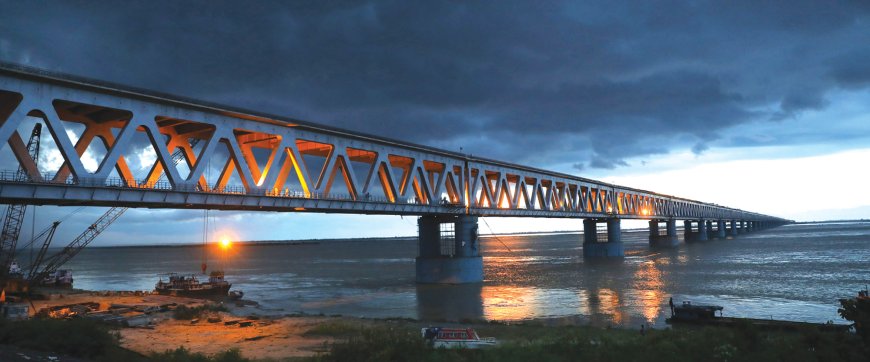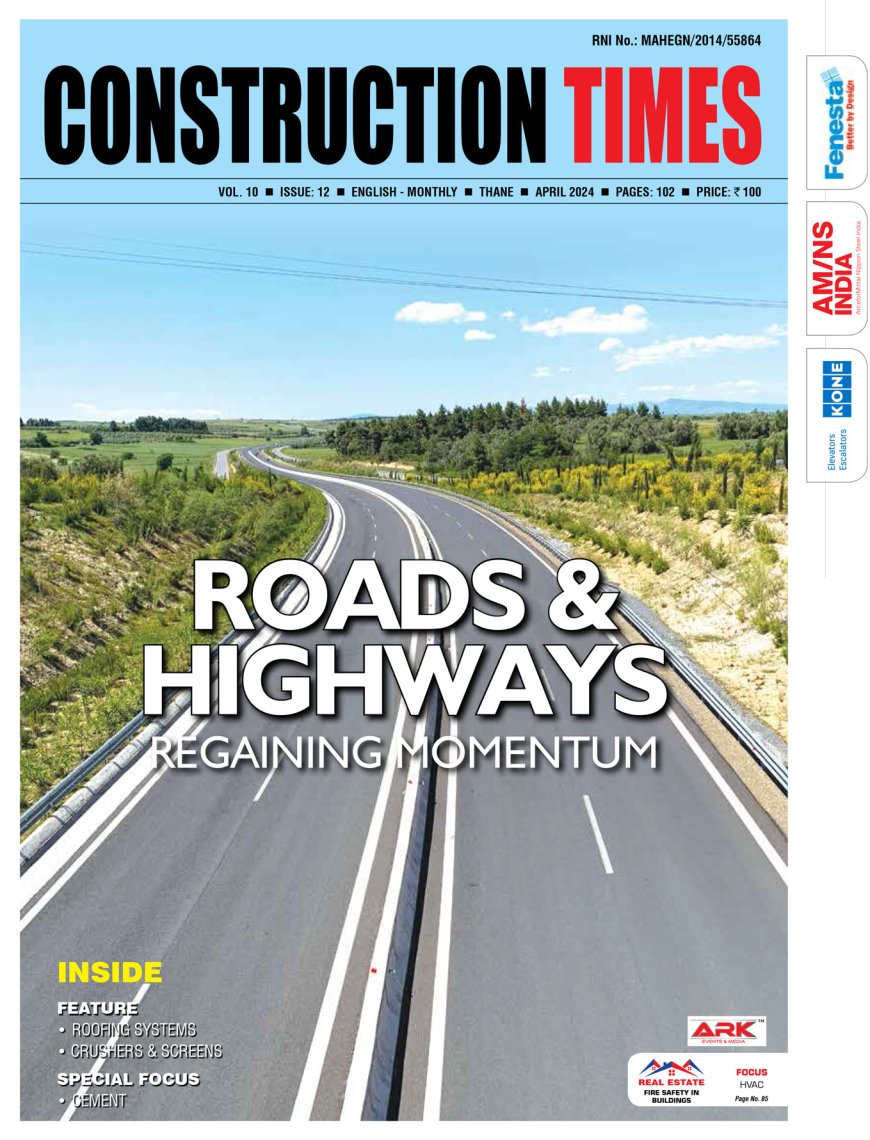THE VITAL LINK

Transportation infrastructure in India has seen a complete turnaround in the past few years with the construction of many iconic projects. The construction of bridges and flyovers takes road and rail connectivity to the next level by bringing far-off areas closer and faster reachable. Construction Times explores what is trending in this vital link of bridges and flyovers and what’s the way forward.
Cities as well as remote locations in India have been planning several infrastructure upgrades including bridges and flyovers at strategic locations to decongest traffic, enable signal-free transit, and bring far-flung areas closer. For example, Bengaluru Municipality in its budget has announced multiple flyovers to decongest the city. MMRDA has announced a slew of bridges and flyovers while few are under construction in the region. Similar projects are planned and under construction in other cities and suburbs. Many bridge projects have also been constructed in the past years while many are in the pipeline for river connectivity, connecting hilly terrains, and even for coastal connectivity.
Bridging the gap
India has seen many landmark bridge projects across the country over the years. These bridges reduce travel time considerably, ensure connectivity round-the-clock, and allow quick and easy accessibility from across the regions. In the recent past, we have seen construction of some key road and rail bridges in the country across the rivers and on the hilly terrains. For example, The Bogibeel Bridge is India’s longest rail-cum road bridge. The 4,940-m-long bridge on the Brahmaputra River is the country’s first fully welded steel bridge with no joints. The bridge reduces the travel time to four hours between two states – Arunachal Pradesh and Assam. The bridge also reduces the travel time between Delhi to Dibrugarh by around three hours to 34 hours. Previously, it used to take 37 hours to cover the distance between the two cities.
The Chenab rail bridge is the world’s tallest railway bridge which is taller than the Eiffel Tower. The Chenab Bridge sits 359 m (around 1,180 ft) above the Chenab River in the Jammu and Kashmir region. The 1,315 m-long (4,314 ft) bridge is part of a broader project to make the Kashmir Valley accessible by the Indian Railway network.
The Bandra-Worli Sea Link is the first-of-its-kind bridge project in India over the sea, which connects Mumbai’s coastline in an arc shape. It is actually a part of the Western Freeway Sea Project, which aims to improve road connectivity in Greater Mumbai. It is Mumbai’s first bridge equipped with ‘seismic arresters’ and can withstand earthquakes of intensity 7 on the Richter Scale. This eight-lane bridge provides smooth traffic throughout the travel and saves time.
India’s longest sea bridge, the Mumbai Trans Harbour Link (MTHL) will be opening soon for commuters. The 21.8-km long and 30.1-m wide, six-lane bridge is expected to cater to 70,000 vehicles daily. The proposed vehicle speed for the bridge is 100 km/hour. The Mumbai Metropolitan Region Development Authority (MMRDA) is implementing the MTHL project, which is financed by the Japan International Cooperation Agency. The longest sea bridge will have a total stretch of 16.5 km above the sea and a land length of about 5.5 km. Connecting Central Mumbai with Navi Mumbai, the MTHL is expected to provide relief to commuters in the Mumbai Metropolitan Region from traffic bottlenecks. According to MMRDA, the bridge is expected to allow people to travel from Sewri in central Mumbai to Chirle in Navi Mumbai in 15-20 minutes.
The construction of the much-awaited Mumbai Coastal Road Project is in full swing after some delays. The Coastal Road project is one of the prestigious road projects being constructed in India’s financial capital. This project has bridges being constructed along the sea coast of Mumbai for a seamless traffic experience and faster transit within Mumbai.
The under-construction Mumbai-Ahmedabad Bullet Train Project also bears many bridges to connect the water bodies in its way. The National High-Speed Rail Corridor Limited (NHSRCL), which is implementing the project is using advanced technologies to construct these bridges. NHSRCL has completed the construction of the first steel bridge of the Mumbai-Ahmedabad Bullet Train project. The 70-m-long bridge has been built across National Highway (NH)-53 at Gujarat’s Surat city. A total of 28 steel bridges will be erected for the Mumbai-Ahmedabad High-Speed Rail (MAHSR) corridor.
There are many more iconic bridge projects under construction that will provide much-needed connectivity in the future.
With a host of expressways and super expressways under construction, flyovers are being constructed on these projects for the free flow of traffic in major junctions and city areas. Flyovers help in signal-free traffic and faster commutes in cities.
Emerging trends
 The escalating urbanisation has made cities more populated than ever, which has resulted in traffic congestion. This creates an overwhelming demand for flyovers and elevated roads to facilitate better connectivity and a seamless commute. The required magnitude of the bridges and flyovers and the responsibility of maintenance warrant a public-private partnership. “Superior quality bridges and flyovers will make the most remote regions of the country accessible to citizens, which will benefit Tier 2 and Tier 3 cities and villages greatly,” says Nikhil Jain, CEO, Qubik Infra. In Manipur, the company is currently engaged in the construction of a significant project involving the assembly of a total of 140-tonne steel prefabricated bridges. “In fact, we have already delivered 10 bridges as part of this initiative, successfully, one of them being the construction of the tallest pier railway bridge in the world (Noney Bridge),” he adds.
The escalating urbanisation has made cities more populated than ever, which has resulted in traffic congestion. This creates an overwhelming demand for flyovers and elevated roads to facilitate better connectivity and a seamless commute. The required magnitude of the bridges and flyovers and the responsibility of maintenance warrant a public-private partnership. “Superior quality bridges and flyovers will make the most remote regions of the country accessible to citizens, which will benefit Tier 2 and Tier 3 cities and villages greatly,” says Nikhil Jain, CEO, Qubik Infra. In Manipur, the company is currently engaged in the construction of a significant project involving the assembly of a total of 140-tonne steel prefabricated bridges. “In fact, we have already delivered 10 bridges as part of this initiative, successfully, one of them being the construction of the tallest pier railway bridge in the world (Noney Bridge),” he adds.
 In the present day and massive infrastructure development initiatives by Government of India, the construction of bridges plays a significant role in roads and railway networks. This becomes more important especially when roads and railway lines cut across major rivers such as Ganga, Yamuna, Godavari, and various mountain ranges etc. Central nodal agencies such as NHAI, MORTH, and state-run corporations are putting major emphasis on bridge construction. According to R Anantakumar, Director (Operations) & Urban Infra BU Head, Afcons Infrastructure, many innovative developments have evolved in modern bridge construction. “The most striking development is undoubtedly the surge of cable-stayed bridge construction with concrete decks and pylons. This type of bridge construction can be faster as the span lengths can be longer, thereby reducing the number of foundations,” he adds.
In the present day and massive infrastructure development initiatives by Government of India, the construction of bridges plays a significant role in roads and railway networks. This becomes more important especially when roads and railway lines cut across major rivers such as Ganga, Yamuna, Godavari, and various mountain ranges etc. Central nodal agencies such as NHAI, MORTH, and state-run corporations are putting major emphasis on bridge construction. According to R Anantakumar, Director (Operations) & Urban Infra BU Head, Afcons Infrastructure, many innovative developments have evolved in modern bridge construction. “The most striking development is undoubtedly the surge of cable-stayed bridge construction with concrete decks and pylons. This type of bridge construction can be faster as the span lengths can be longer, thereby reducing the number of foundations,” he adds.
Afcons has successfully executed landmark bridge projects such as Chenab Railway Bridge – world’s highest single-arch railway bridge, MG Setu – the longest steel bridge in India, Vallarpadam Railway Bridge – one of the longest railway bridges in India, 16 bridges for USBRL project in J&K, etc. “Our focus is on taking challenging bridge projects involving cable-stayed, extra-dosed, cable suspension, arch bridges, which require high technological designs, best safety standards along with unique aesthetic appeal. Our operational excellence framework enhances our ability to deliver the most complex and challenging projects on time, or, ahead of schedule. We will continue to play a vital role in India’s infra growth,” Anantakumar says.
Technology trends
 With the advancement in technology and design, the scenario has seen a radical shift from the past, according to Nagesh Veeturi, Executive Director – Civil, KEC International. “Modern equipment and evolved design philosophies are enabling contractors to implement newer and better execution methodologies such as cantilever construction, steel arch bridges, orthotropic deck bridges, etc. These technologies not only enable faster and safer execution, but also allow for better-finished structures, lower maintenance, and better aesthetics. Some bridges are being built holistically combining two distinct methodologies (such as precast box girders and cables) to create new composite structures,” he adds.
With the advancement in technology and design, the scenario has seen a radical shift from the past, according to Nagesh Veeturi, Executive Director – Civil, KEC International. “Modern equipment and evolved design philosophies are enabling contractors to implement newer and better execution methodologies such as cantilever construction, steel arch bridges, orthotropic deck bridges, etc. These technologies not only enable faster and safer execution, but also allow for better-finished structures, lower maintenance, and better aesthetics. Some bridges are being built holistically combining two distinct methodologies (such as precast box girders and cables) to create new composite structures,” he adds.
KEC’s Civil Infra Business is currently working on the construction of a new 560-m-long, the first-ever metro bridge over the Yamuna, to be built using a balanced cantilever construction technique. A balance cantilever is used to attach the segments in an alternate manner at opposite ends of cantilevers supported by piers. Cantilever construction allows overhanging structures without additional support. Veeturi elaborates, “The bridge’s design was finalized using the ‘Building Information Modelling’ (BIM) and Revit software. With the help of these technologies, a 3D model of the bridge was uploaded with intricate details of the proposed structure. Usage of this technology will make the bridge look aesthetically better. The bridge, with eight spans and nine piers, will connect Soorghat metro station and Sonia Vihar metro station of the Pink Line.”
Role of digital tools
 The construction of bridges and flyovers has witnessed a significant transformation in recent years, driven by swift technological advancements and evolution in construction methods. Harsh Pareek, Regional Sales Director, India, and SAARC, Trimble Solutions, elaborates, “In many progressive countries including India, a significant proportion of large-scale bridge or flyover projects today employ BrIM or Bridge Information Modeling, to accurately plan, engineer and execute the construction. The use of BrIM, combined with sophisticated project management tools and other software optimises project workflows, reduces materials wastage, and helps construction companies finish these complex projects on time and within budgets.”
The construction of bridges and flyovers has witnessed a significant transformation in recent years, driven by swift technological advancements and evolution in construction methods. Harsh Pareek, Regional Sales Director, India, and SAARC, Trimble Solutions, elaborates, “In many progressive countries including India, a significant proportion of large-scale bridge or flyover projects today employ BrIM or Bridge Information Modeling, to accurately plan, engineer and execute the construction. The use of BrIM, combined with sophisticated project management tools and other software optimises project workflows, reduces materials wastage, and helps construction companies finish these complex projects on time and within budgets.”
 Kamalakannan Thiruvadi, Regional Executive, South Asia, Bentley Systems, shares more on digital technologies in bridge construction, “In the context of bridge and flyover construction in India, cutting-edge technologies are revolutionising the process of Design, Construction and Operation & Maintenance; BIM, Construction Project Management & Controls and Digital Twins, to name a few. Drones, LiDAR technology, and IOT sensors enable accurate surveying and monitoring of the structural health and safety of the assets.”
Kamalakannan Thiruvadi, Regional Executive, South Asia, Bentley Systems, shares more on digital technologies in bridge construction, “In the context of bridge and flyover construction in India, cutting-edge technologies are revolutionising the process of Design, Construction and Operation & Maintenance; BIM, Construction Project Management & Controls and Digital Twins, to name a few. Drones, LiDAR technology, and IOT sensors enable accurate surveying and monitoring of the structural health and safety of the assets.”
Looking ahead
Bridges and flyovers are major infrastructure assets that not only serve as vital cogs in the nation’s infrastructure – ensuring smoother transportation – but also often take several months or years to build and can cost several crores of taxpayers’ money. In this scenario, Pareek is of the view that progressive countries like India will soon transition towards a new approach to building and operating bridges and flyovers known as ‘Integrated Asset Lifecycle Management’. “Ultimately, we believe the ongoing digitalisation of public infrastructure creation and operational usage will radically transform how we build and operate bridges and flyovers in the future, and we as a global technology leader are ready and prepared to support the Indian construction industry in its digital transformation,” he adds.
Veeturi is optimistic as he states, “Due to KEC’s expertise in viaduct construction from its metro projects, the company is well-positioned to tackle the complexities involved in flyover and bridge projects. We are constantly on the lookout for potential projects that will allow us to leverage not only our expertise in bridges but also other capabilities. With the ever-increasing demand for road infrastructure and the availability of the latest construction technologies, KEC is fully prepared to take on the challenges involved in construction.”
 From a technology and machinery perspective, V G Sakthikumar, Chairman & Managing Director, Schwing Stetter India, says, “We are optimistic about the growth prospects of the bridges and flyovers construction market and are committed to providing innovative and sustainable solutions to our customers in this sector. We believe that our expertise, global reach, and commitment to quality will position us well to capitalize on the opportunities in this market.”
From a technology and machinery perspective, V G Sakthikumar, Chairman & Managing Director, Schwing Stetter India, says, “We are optimistic about the growth prospects of the bridges and flyovers construction market and are committed to providing innovative and sustainable solutions to our customers in this sector. We believe that our expertise, global reach, and commitment to quality will position us well to capitalize on the opportunities in this market.”
On a broader perspective, more bridges and flyovers will be needed in the future to effectively meet the anticipated growth in traffic density considering the increasing urbanization and modernization happening in every business segment and developing transport infrastructure.








